A Critical Analysis of Social Legislation on Youth Homelessness in NSW
VerifiedAdded on 2022/10/10
|7
|1067
|177
Report
AI Summary
This report provides a critical analysis of the Supported Accommodation Assistance Act 1994 in New South Wales, focusing on its impact on youth homelessness. The report examines the various factors contributing to youth homelessness, including domestic violence, lack of affordable housing, and mental health issues. It discusses the strengths of the Act, such as government-funded support services and casework management, while also addressing its constraints, including limited resources for those with disabilities and lack of awareness of the law. The report further analyzes the design of the legislation and suggests social reforms to improve social work services, advocating for cultural diversity, special attention to vulnerable groups, and increased funding to effectively combat youth homelessness. The conclusion emphasizes the ongoing nature of this issue and the need for continuous improvements to the Act and related social work practices to provide more permanent solutions.
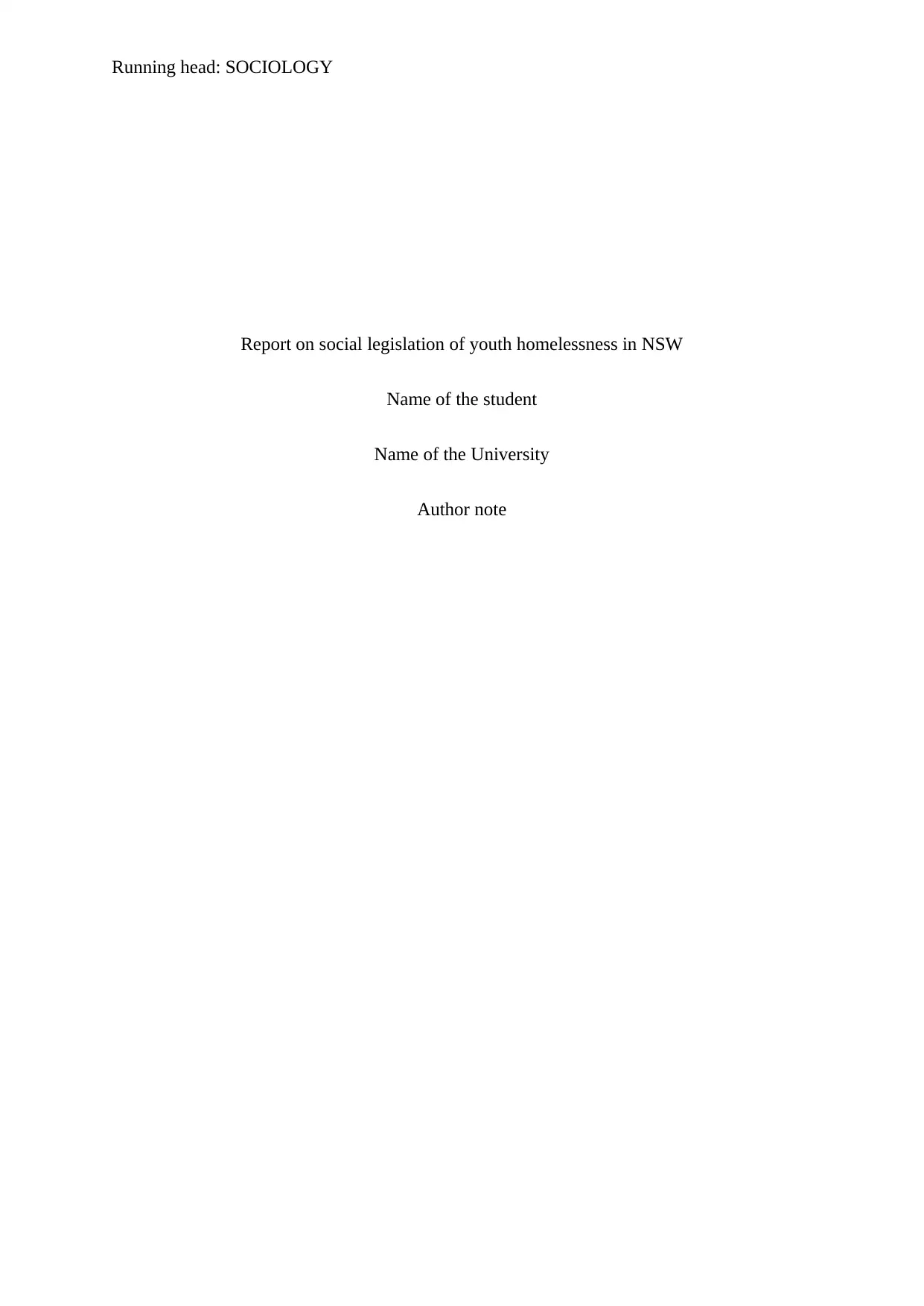
Running head: SOCIOLOGY
Report on social legislation of youth homelessness in NSW
Name of the student
Name of the University
Author note
Report on social legislation of youth homelessness in NSW
Name of the student
Name of the University
Author note
Paraphrase This Document
Need a fresh take? Get an instant paraphrase of this document with our AI Paraphraser

1
SOCIOLOGY
Executive summary
The following report aims to critically analyse a piece of social legislation discussing its
strength and constraints regarding its design or application. The social legislation chosen for
this report is Supported Accommodation Assistance Act 1994. Homelessness in youth is
observed as one of leading social issue across the globe. The report discusses in details of the
various aspects of the law in discussion. The report concludes on the possible social reforms
that can enhance social work services in NSW.
SOCIOLOGY
Executive summary
The following report aims to critically analyse a piece of social legislation discussing its
strength and constraints regarding its design or application. The social legislation chosen for
this report is Supported Accommodation Assistance Act 1994. Homelessness in youth is
observed as one of leading social issue across the globe. The report discusses in details of the
various aspects of the law in discussion. The report concludes on the possible social reforms
that can enhance social work services in NSW.
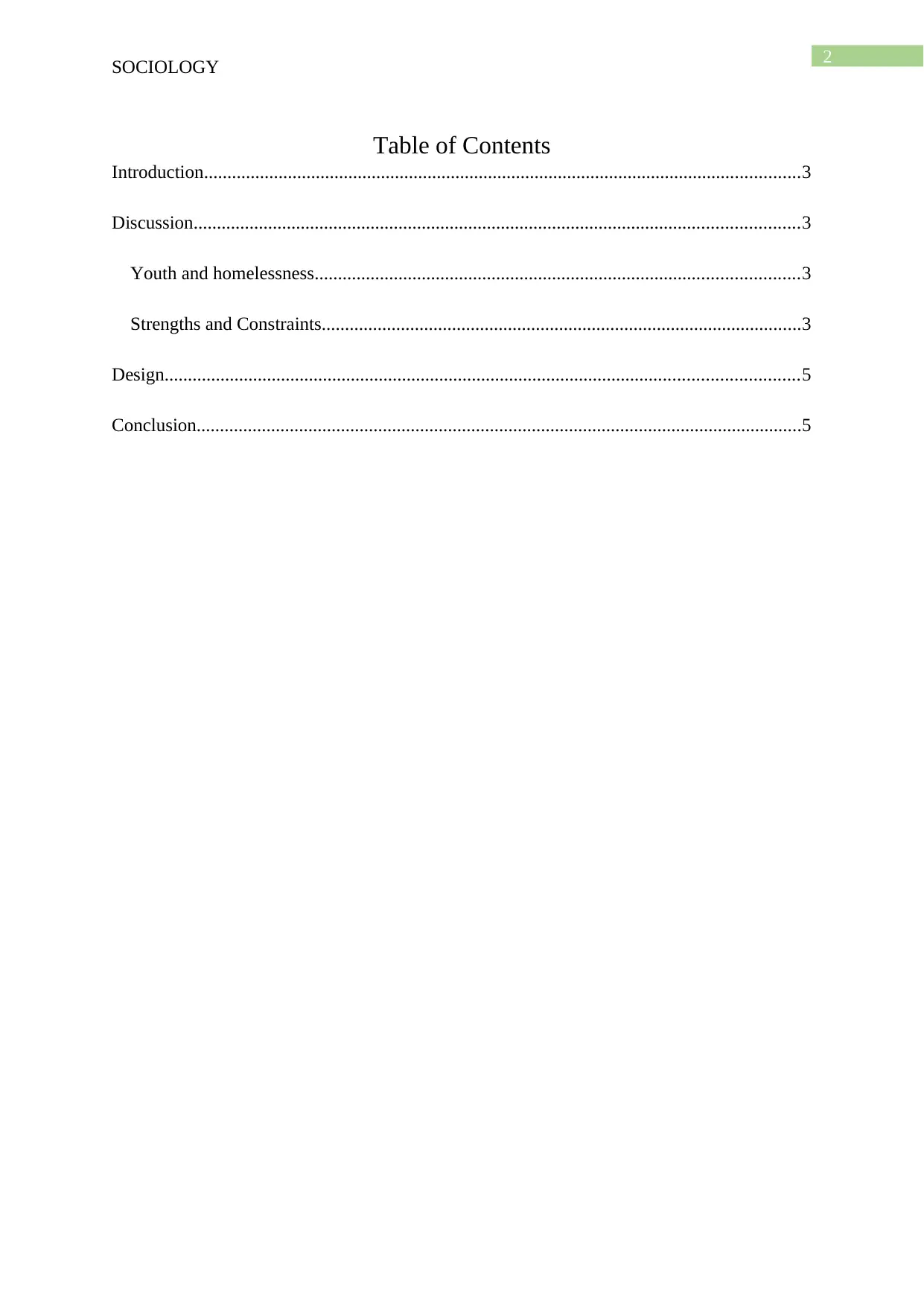
2
SOCIOLOGY
Table of Contents
Introduction................................................................................................................................3
Discussion..................................................................................................................................3
Youth and homelessness........................................................................................................3
Strengths and Constraints.......................................................................................................3
Design........................................................................................................................................5
Conclusion..................................................................................................................................5
SOCIOLOGY
Table of Contents
Introduction................................................................................................................................3
Discussion..................................................................................................................................3
Youth and homelessness........................................................................................................3
Strengths and Constraints.......................................................................................................3
Design........................................................................................................................................5
Conclusion..................................................................................................................................5
⊘ This is a preview!⊘
Do you want full access?
Subscribe today to unlock all pages.

Trusted by 1+ million students worldwide
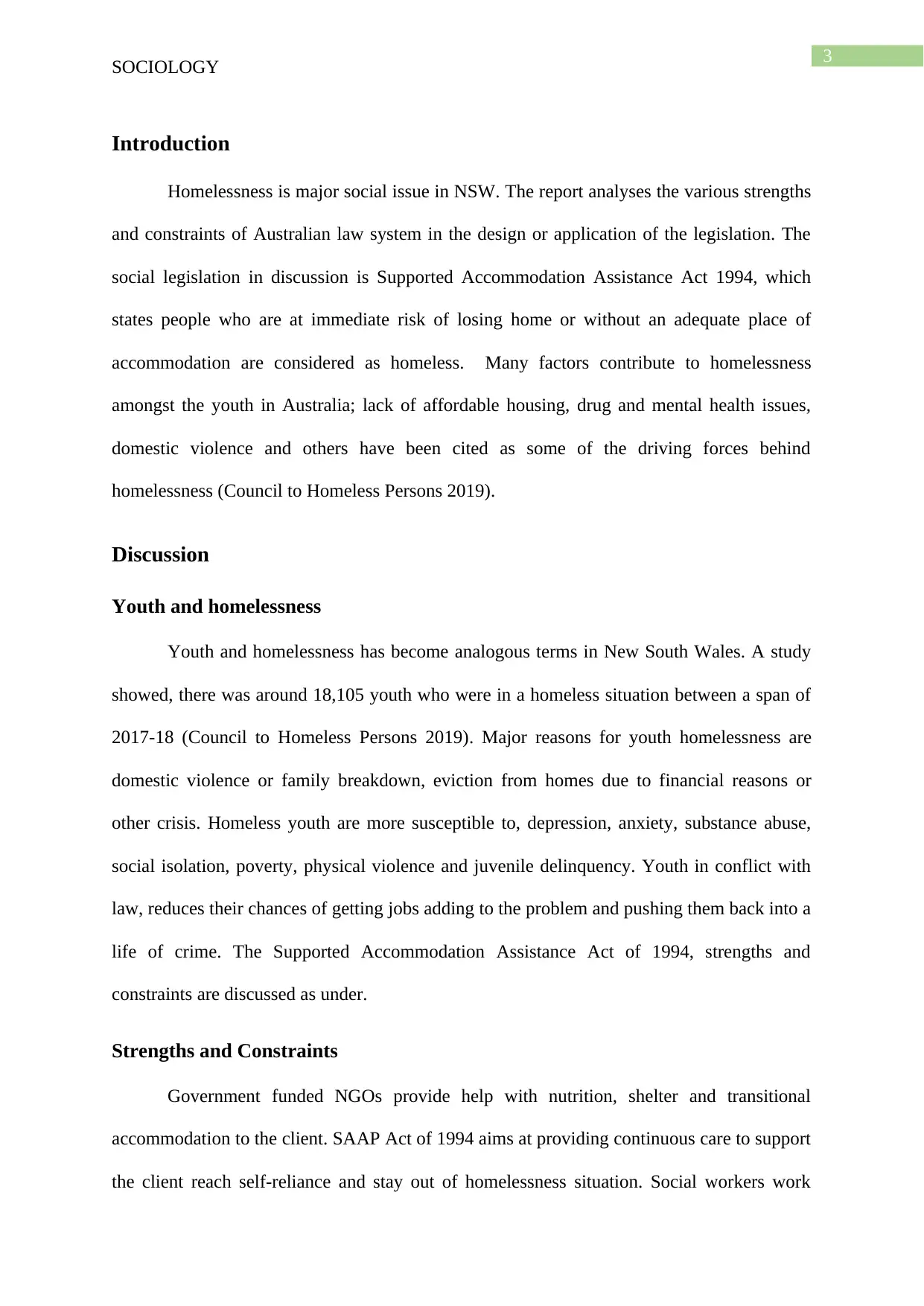
3
SOCIOLOGY
Introduction
Homelessness is major social issue in NSW. The report analyses the various strengths
and constraints of Australian law system in the design or application of the legislation. The
social legislation in discussion is Supported Accommodation Assistance Act 1994, which
states people who are at immediate risk of losing home or without an adequate place of
accommodation are considered as homeless. Many factors contribute to homelessness
amongst the youth in Australia; lack of affordable housing, drug and mental health issues,
domestic violence and others have been cited as some of the driving forces behind
homelessness (Council to Homeless Persons 2019).
Discussion
Youth and homelessness
Youth and homelessness has become analogous terms in New South Wales. A study
showed, there was around 18,105 youth who were in a homeless situation between a span of
2017-18 (Council to Homeless Persons 2019). Major reasons for youth homelessness are
domestic violence or family breakdown, eviction from homes due to financial reasons or
other crisis. Homeless youth are more susceptible to, depression, anxiety, substance abuse,
social isolation, poverty, physical violence and juvenile delinquency. Youth in conflict with
law, reduces their chances of getting jobs adding to the problem and pushing them back into a
life of crime. The Supported Accommodation Assistance Act of 1994, strengths and
constraints are discussed as under.
Strengths and Constraints
Government funded NGOs provide help with nutrition, shelter and transitional
accommodation to the client. SAAP Act of 1994 aims at providing continuous care to support
the client reach self-reliance and stay out of homelessness situation. Social workers work
SOCIOLOGY
Introduction
Homelessness is major social issue in NSW. The report analyses the various strengths
and constraints of Australian law system in the design or application of the legislation. The
social legislation in discussion is Supported Accommodation Assistance Act 1994, which
states people who are at immediate risk of losing home or without an adequate place of
accommodation are considered as homeless. Many factors contribute to homelessness
amongst the youth in Australia; lack of affordable housing, drug and mental health issues,
domestic violence and others have been cited as some of the driving forces behind
homelessness (Council to Homeless Persons 2019).
Discussion
Youth and homelessness
Youth and homelessness has become analogous terms in New South Wales. A study
showed, there was around 18,105 youth who were in a homeless situation between a span of
2017-18 (Council to Homeless Persons 2019). Major reasons for youth homelessness are
domestic violence or family breakdown, eviction from homes due to financial reasons or
other crisis. Homeless youth are more susceptible to, depression, anxiety, substance abuse,
social isolation, poverty, physical violence and juvenile delinquency. Youth in conflict with
law, reduces their chances of getting jobs adding to the problem and pushing them back into a
life of crime. The Supported Accommodation Assistance Act of 1994, strengths and
constraints are discussed as under.
Strengths and Constraints
Government funded NGOs provide help with nutrition, shelter and transitional
accommodation to the client. SAAP Act of 1994 aims at providing continuous care to support
the client reach self-reliance and stay out of homelessness situation. Social workers work
Paraphrase This Document
Need a fresh take? Get an instant paraphrase of this document with our AI Paraphraser
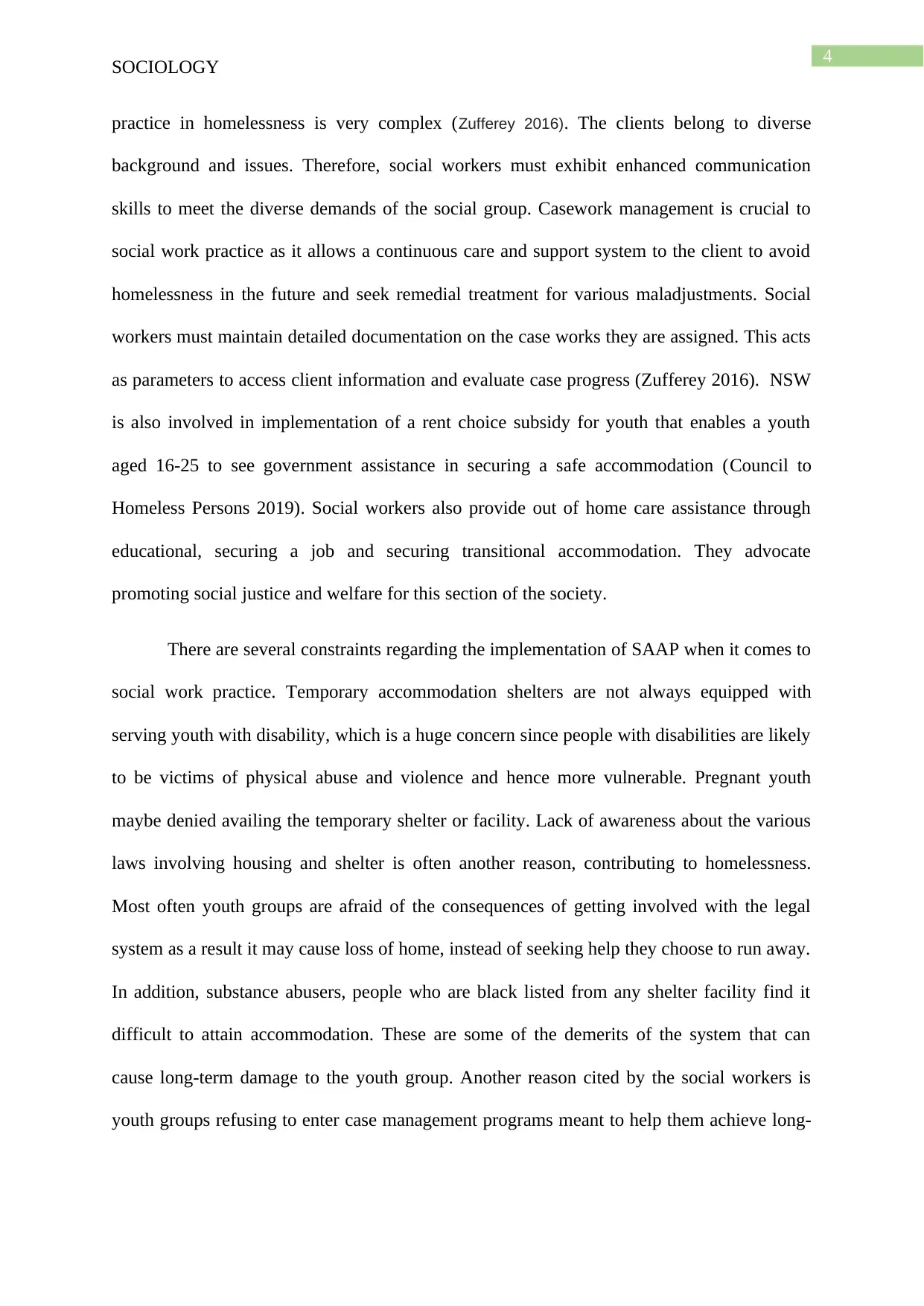
4
SOCIOLOGY
practice in homelessness is very complex (Zufferey 2016). The clients belong to diverse
background and issues. Therefore, social workers must exhibit enhanced communication
skills to meet the diverse demands of the social group. Casework management is crucial to
social work practice as it allows a continuous care and support system to the client to avoid
homelessness in the future and seek remedial treatment for various maladjustments. Social
workers must maintain detailed documentation on the case works they are assigned. This acts
as parameters to access client information and evaluate case progress (Zufferey 2016). NSW
is also involved in implementation of a rent choice subsidy for youth that enables a youth
aged 16-25 to see government assistance in securing a safe accommodation (Council to
Homeless Persons 2019). Social workers also provide out of home care assistance through
educational, securing a job and securing transitional accommodation. They advocate
promoting social justice and welfare for this section of the society.
There are several constraints regarding the implementation of SAAP when it comes to
social work practice. Temporary accommodation shelters are not always equipped with
serving youth with disability, which is a huge concern since people with disabilities are likely
to be victims of physical abuse and violence and hence more vulnerable. Pregnant youth
maybe denied availing the temporary shelter or facility. Lack of awareness about the various
laws involving housing and shelter is often another reason, contributing to homelessness.
Most often youth groups are afraid of the consequences of getting involved with the legal
system as a result it may cause loss of home, instead of seeking help they choose to run away.
In addition, substance abusers, people who are black listed from any shelter facility find it
difficult to attain accommodation. These are some of the demerits of the system that can
cause long-term damage to the youth group. Another reason cited by the social workers is
youth groups refusing to enter case management programs meant to help them achieve long-
SOCIOLOGY
practice in homelessness is very complex (Zufferey 2016). The clients belong to diverse
background and issues. Therefore, social workers must exhibit enhanced communication
skills to meet the diverse demands of the social group. Casework management is crucial to
social work practice as it allows a continuous care and support system to the client to avoid
homelessness in the future and seek remedial treatment for various maladjustments. Social
workers must maintain detailed documentation on the case works they are assigned. This acts
as parameters to access client information and evaluate case progress (Zufferey 2016). NSW
is also involved in implementation of a rent choice subsidy for youth that enables a youth
aged 16-25 to see government assistance in securing a safe accommodation (Council to
Homeless Persons 2019). Social workers also provide out of home care assistance through
educational, securing a job and securing transitional accommodation. They advocate
promoting social justice and welfare for this section of the society.
There are several constraints regarding the implementation of SAAP when it comes to
social work practice. Temporary accommodation shelters are not always equipped with
serving youth with disability, which is a huge concern since people with disabilities are likely
to be victims of physical abuse and violence and hence more vulnerable. Pregnant youth
maybe denied availing the temporary shelter or facility. Lack of awareness about the various
laws involving housing and shelter is often another reason, contributing to homelessness.
Most often youth groups are afraid of the consequences of getting involved with the legal
system as a result it may cause loss of home, instead of seeking help they choose to run away.
In addition, substance abusers, people who are black listed from any shelter facility find it
difficult to attain accommodation. These are some of the demerits of the system that can
cause long-term damage to the youth group. Another reason cited by the social workers is
youth groups refusing to enter case management programs meant to help them achieve long-
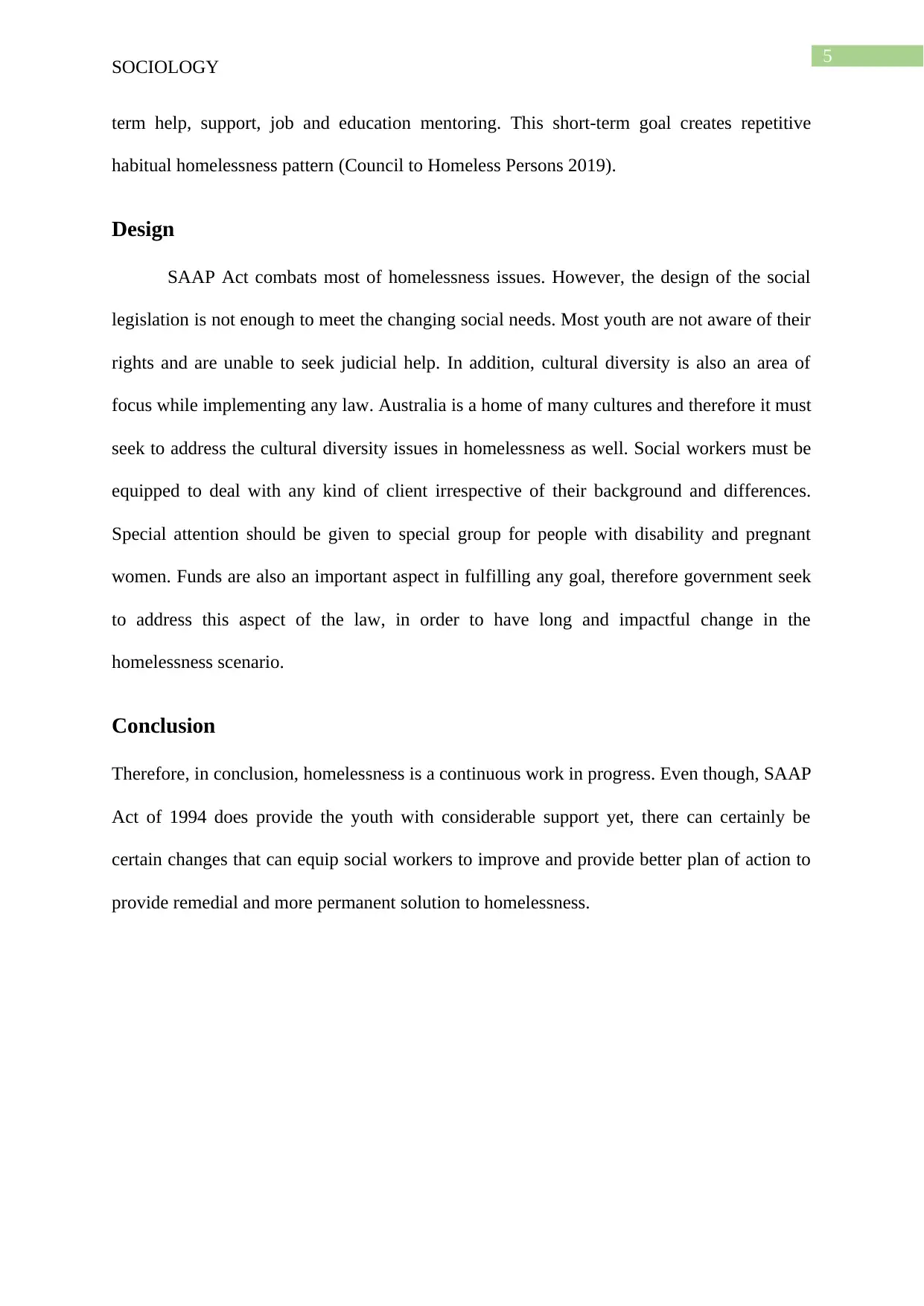
5
SOCIOLOGY
term help, support, job and education mentoring. This short-term goal creates repetitive
habitual homelessness pattern (Council to Homeless Persons 2019).
Design
SAAP Act combats most of homelessness issues. However, the design of the social
legislation is not enough to meet the changing social needs. Most youth are not aware of their
rights and are unable to seek judicial help. In addition, cultural diversity is also an area of
focus while implementing any law. Australia is a home of many cultures and therefore it must
seek to address the cultural diversity issues in homelessness as well. Social workers must be
equipped to deal with any kind of client irrespective of their background and differences.
Special attention should be given to special group for people with disability and pregnant
women. Funds are also an important aspect in fulfilling any goal, therefore government seek
to address this aspect of the law, in order to have long and impactful change in the
homelessness scenario.
Conclusion
Therefore, in conclusion, homelessness is a continuous work in progress. Even though, SAAP
Act of 1994 does provide the youth with considerable support yet, there can certainly be
certain changes that can equip social workers to improve and provide better plan of action to
provide remedial and more permanent solution to homelessness.
SOCIOLOGY
term help, support, job and education mentoring. This short-term goal creates repetitive
habitual homelessness pattern (Council to Homeless Persons 2019).
Design
SAAP Act combats most of homelessness issues. However, the design of the social
legislation is not enough to meet the changing social needs. Most youth are not aware of their
rights and are unable to seek judicial help. In addition, cultural diversity is also an area of
focus while implementing any law. Australia is a home of many cultures and therefore it must
seek to address the cultural diversity issues in homelessness as well. Social workers must be
equipped to deal with any kind of client irrespective of their background and differences.
Special attention should be given to special group for people with disability and pregnant
women. Funds are also an important aspect in fulfilling any goal, therefore government seek
to address this aspect of the law, in order to have long and impactful change in the
homelessness scenario.
Conclusion
Therefore, in conclusion, homelessness is a continuous work in progress. Even though, SAAP
Act of 1994 does provide the youth with considerable support yet, there can certainly be
certain changes that can equip social workers to improve and provide better plan of action to
provide remedial and more permanent solution to homelessness.
⊘ This is a preview!⊘
Do you want full access?
Subscribe today to unlock all pages.

Trusted by 1+ million students worldwide

6
SOCIOLOGY
Reference
Council to Homeless Persons. (2019). Youth homelessness fact sheets and resources -
Council to Homeless Persons. [online] Available at: https://chp.org.au/homelessness/youth-
homelessness/ [Accessed 7 Aug. 2019].
Zufferey, C., 2016. Homelessness and social work: An intersectional approach. Routledge.
SOCIOLOGY
Reference
Council to Homeless Persons. (2019). Youth homelessness fact sheets and resources -
Council to Homeless Persons. [online] Available at: https://chp.org.au/homelessness/youth-
homelessness/ [Accessed 7 Aug. 2019].
Zufferey, C., 2016. Homelessness and social work: An intersectional approach. Routledge.
1 out of 7
Related Documents
Your All-in-One AI-Powered Toolkit for Academic Success.
+13062052269
info@desklib.com
Available 24*7 on WhatsApp / Email
![[object Object]](/_next/static/media/star-bottom.7253800d.svg)
Unlock your academic potential
Copyright © 2020–2025 A2Z Services. All Rights Reserved. Developed and managed by ZUCOL.





